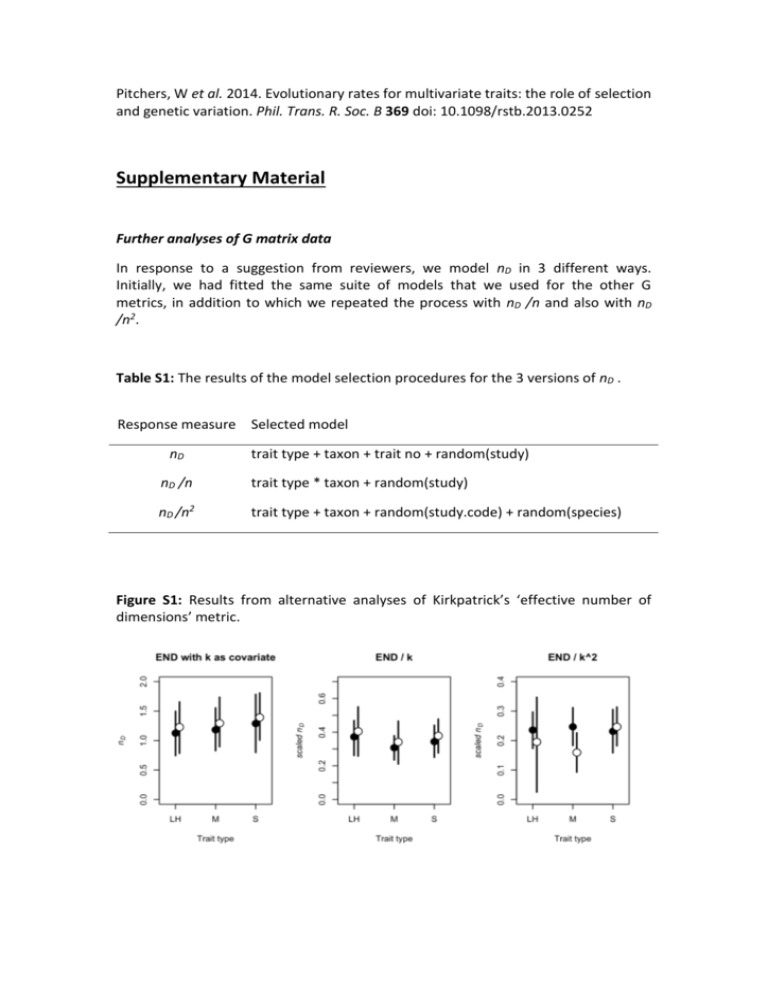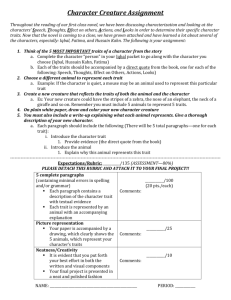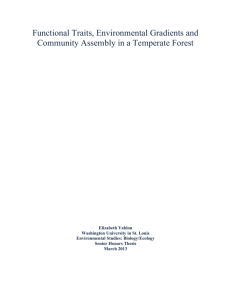Supplemental Analyses - Philosophical Transactions of the Royal
advertisement

Pitchers, W et al. 2014. Evolutionary rates for multivariate traits: the role of selection and genetic variation. Phil. Trans. R. Soc. B 369 doi: 10.1098/rstb.2013.0252 Supplementary Material Further analyses of G matrix data In response to a suggestion from reviewers, we model nD in 3 different ways. Initially, we had fitted the same suite of models that we used for the other G metrics, in addition to which we repeated the process with nD /n and also with nD /n2. Table S1: The results of the model selection procedures for the 3 versions of nD . Response measure Selected model nD trait type + taxon + trait no + random(study) nD /n trait type * taxon + random(study) nD /n2 trait type + taxon + random(study.code) + random(species) Figure S1: Results from alternative analyses of Kirkpatrick’s ‘effective number of dimensions’ metric. Figure S2: Density of the number of traits for out 2 G matrix datasets. Note that in both cases the majority of matrices are for between 4 & 6 traits. It is possible that there are effects associated with the number of traits that we have been unable to detect due to a lack of power. Only with a larger sample of larger matrices could we test this. Table S2: The counts of numbers of matrices of each size (in terms of number of traits) represented in both our matrix datasets. n covariance matrix count correlation matrix count 2 11 31 3 8 41 4 5 36 5 29 42 6 16 21 7 6 21 8 2 17 9 3 5 10 4 17 1 3 total 81 221 We mentioned in the Discussion section that one legitimate concern with a quantitative review of the structure of G is that G can be challenging to estimate, and extremely challenging to estimate well. In particular, a smaller-than-optimal sample of families in a breeding design has the potential to inflate the magnitude of the gmax, at the expense of the minor eigenvalues [55,56]. Given the importance of the ‘lines of least evolutionary resistance’ and ‘genetic degrees of freedom’ concepts for our thinking about multivariate evolution, it is a useful (not to mention reassuring) finding that there is no evidence to suggest that these patterns are driven by the sample sizes of the studies involved. Figure S3: Pairs plot of the subset of covariance matrix measures that appear to represent the structure (as opposed to the magnitude) of G, in addition to the number of families measured to estimate G. (This plot does not include matrices estimated using an animal model, only those that result from breeding designs. ‘families’ in this case was taken to mean the number of sires in a half-sib design and the number of dams in parent-offspring regressions) Figure S4: Pairs plot of the subset of correlation matrix measures that appear to represent the structure (as opposed to the magnitude) of G, in addition to the number of families measured to estimate G. (This plot does not include matrices estimated using an animal model, only those that result from breeding designs. ‘families’ in this case was taken to mean the number of sires in a half-sib design and the number of dams in parent-offspring regressions) Further analyses of selection data In the main MS we only reported our findings from linear selection gradient () data. However, in the process of collecting these estimates we also tabulated estimates of quadratic selection gradients (the diagonal elements of the matrix). These estimates were reported less frequently than those for , and there is a smaller dataset to work with. We divided the quadratic gradients into to groups; negative (potentially stabilizing) and positive (potentially disruptive) gradients. For each of these subsets, we fit the same model as used for the dataset (a formal Bayesian meta-analysis following [38]: see main text), the results of which are visualized in Figure S5 below. Firstly, we should note that there are no differences among trait types or between taxa in which can have a high level of confidence. It is interesting to not that, for both taxa, there appear to be different trends in the two subsets of quadratic gradients, but we can say little more than that with the currently available data. Figure S5: Posterior means and 95% credible intervals for negative (left panel) and positive (right panel) quadratic selection gradients. Trait types are life-history (LH), morphology (M) and sexually selected (S) and filled points are for animals and open points for plants.











